Integrating Internet of Things (IoT) Approach to Post-Occupancy Evaluation (POE): An Experimental At-the-Moment Occupant Comfort Control System
Abstract
:1. Introduction
2. Background
3. Materials and Methods
3.1. Experiment Preliminaries
3.2. Pilot Study
3.3. Experiment Process
4. Results
4.1. Overall Environmental Performance
4.2. CO2 Concentration Readings in the Office Space and at the Different Zones
4.3. Number of Alert Triggers
4.4. Perception of Indoor Air Quality and Its Productivity Level upon CO2 Alert Trigger
4.5. Correlation between CO2 Concentration Reading and the Perception of Participants about Stuffiness of Indoor Air, Productivity Level, and Health of the Environment
4.6. Effectiveness of Mitigation Measures
4.7. Participants’ Perception of User Friendliness of the Developed IoT Platform
5. Discussion
Lessons Learned
6. Conclusions
Author Contributions
Funding
Institutional Review Board Statement
Data Availability Statement
Acknowledgments
Conflicts of Interest
References
- Marchetti, N.; Cavazzini, A.; Pasti, L.; Catani, M.; Malagù, C.; Guidi, V. A campus sustainability initiative: Indoor air quality monitoring in classrooms. In Proceedings of the 2015 XVIII AISEM Annual Conference, Trento, Italy, 3–5 February 2015; pp. 1–4. [Google Scholar] [CrossRef]
- Dai, C.; Zhang, H.; Arens, E.; Lian, Z. Machine learning approaches to predict thermal demands using skin temperatures: Steady-state conditions. Build. Environ. 2017, 114, 1–10. [Google Scholar] [CrossRef]
- Al Horr, Y.; Arif, M.; Kaushik, A.; Mazroei, A.; Katafygiotou, M.; Elsarrag, E. Occupant productivity and office indoor environment quality: A review of the literature. Build. Environ. 2016, 105, 369–389. [Google Scholar] [CrossRef]
- Agoplan, N. Don’t Breathe Easy: The Adverse Effects of Poor Indoor Air Quality. RenewAire Energy Recovery Ventilation. Available online: https://www.renewaire.com/wp-content/uploads/2017/09/MAR_LIT_107_RGB_White_Paper_Adverse_Effects_of_Poor_Indoor_Air_Quality.pdf (accessed on 6 June 2024).
- Salthammer, T.; Morrison, G.C. Temperature and indoor environments. Indoor Air 2022, 32, e13022. [Google Scholar] [CrossRef]
- Chen, D.; Huebner, G.; Bagkeris, E.; Ucci, M.; Mumovic, D. Effects of short-term exposure to moderate pure carbon dioxide levels on cognitive performance, health symptoms and perceived indoor environment quality. Build. Environ. 2023, 245, 110967. [Google Scholar] [CrossRef]
- Joshi, S.M. The sick building syndrome. Indian J. Occup. Environ. Med. 2008, 12, 61–64. [Google Scholar] [CrossRef]
- Onyeizu, E. Can Architecture Increase Productivity? A Case of Green Buildings. Ph.D. Thesis, The University of Auckland, Auckland, New Zealand, 2014. [Google Scholar]
- UNEP. 2022 Global Status Report for Buildings and Construction; UNEP: Nairobi, Kenya, 2022. [Google Scholar]
- Rasheed, E.O.; Khoshbakht, M.; Baird, G. Does the Number of Occupants in an Office Influence Individual Perceptions of Comfort and Productivity?-New Evidence from 5000 Office Workers. Buildings 2019, 9, 73. [Google Scholar] [CrossRef]
- Rasheed, E.O.; Khoshbakht, M.; Baird, G. “Do office workers’ comments corroborate the ratings they give their buildings?” A qualitative analysis of comments on operational factors in the workplace. Facilities 2024, 42, 274–320. [Google Scholar] [CrossRef]
- World Health Organization [WHO]. Global Action Plan on Physical Activity 2018–2030: More Active People for a Healthier World; World Health Organization: Geneva, Switzerland, 2019.
- NoVA Environmental Solutions (2024) the True Cost of Poor Indoor Air Quality. Available online: https://www.novaenvironmentalsolutions.com/the-true-cost-of-poor-indoor-air-quality/ (accessed on 6 June 2024).
- Berg, B.L.; Dowdell, D.C.; Curtis, M.D. New Zealand Whole-Building Whole-of-Life Framework: Development of Reference Office Buildings for Use in Early Design; BRANZ: Porirua, New Zealand, 2016. [Google Scholar]
- World Green Building Council [WorldGBC]. Building the Business Case: Health, Wellbeing and Productivity in Green Offices. 2016. Available online: https://worldgbc.org/article/building-the-business-case-health-wellbeing-and-productivity-in-green-offices/ (accessed on 6 June 2024).
- IEA. Tracking Clean Energy Progress 2023; IEA: Paris, France, 2023. [Google Scholar]
- Byrd, H.; Matthewman, S.; Rasheed, E. Air-conditioning in New Zealand: Power and policy. Build. Cities 2022, 3, 1–9. [Google Scholar] [CrossRef]
- Hong, T.; Taylor-Lange, S.C.; D’Oca, S.; Yan, D.; Corgnati, S.P. Advances in research and applications of energy-related occupant behavior in buildings. Energy Build. 2016, 116, 694–702. [Google Scholar] [CrossRef]
- Rasheed, E.; Rotimi, J.; Vilasini, N.; Weerasinghe, A. Proactive post-occupancy evaluation. Build 2021, 185, 68–69. [Google Scholar]
- Weerasinghe, A.S.; Rasheed, E.O.; Rotimi, J.O. Occupants’ Decision-Making of Their Energy Behaviours in Office Environments: A Case of New Zealand. Sustainability 2022, 15, 2305. [Google Scholar] [CrossRef]
- Weerasinghe, A.; Rotimi, J.; Rasheed, E.O. Modelling of underlying social psychological effects on occupant energy-related behaviours. Build. Environ. 2023, 231, 110055. [Google Scholar] [CrossRef]
- Lou, H.; Ou, D. The effects of speech intelligibility on English scientific literature reading in Chinese open-plan offices. J. Acoust. Soc. Am. 2020, 147, EL1–EL6. [Google Scholar] [CrossRef] [PubMed]
- Roberts, C.J.; Edwards, D.J.; Sing, M.C.P.; Aigbavboa, C. Post-Occupancy Evaluation: Process Delineation and Implementation Trends in the UK Higher Education Sector. Archit. Eng. Des. Manag. 2021, 19, 125–147. [Google Scholar] [CrossRef]
- Zimring, C.; Rosenheck, T. Getting It Right the Second or Third Time Rather than the Sixth or Seventh. California Department of General Services. DGS POE Program. 2001. Available online: http://www.poe.dgs.ca.gov/info/ffctalk.asp (accessed on 6 June 2024).
- Zimmerman, A.; Martin, M. Post-occupancy evaluation: Benefits and barriers. Build. Res. Inf. 2001, 29, 168–174. [Google Scholar] [CrossRef]
- Ahmed, H.; Edwards, D.J.; Lai, J.H.K.; Roberts, C.; Debrah, C.; Owusu-Manu, D.-G.; Thwala, W.D. Post occupancy evaluation of school refurbishment projects: Multiple case study in the, U.K. Buildings 2021, 11, 169. [Google Scholar] [CrossRef]
- Pomponi, F.; Moncaster, A. Circular economy for the built environment: A research framework. J. Clean. Prod. 2017, 143, 710–718. [Google Scholar] [CrossRef]
- Lolli, F.; Marinello, S.; Coruzzolo, A.M.; Butturi, M.A. Post-Occupancy Evaluation’s (POE) Applications for Improving Indoor Environment Quality (IEQ). Toxics 2022, 10, 626. [Google Scholar] [CrossRef]
- Alborz, N.; Berardi, U. A post occupancy evaluation framework for LEED certified U.S higher education residence Halls. Procedia Eng. 2015, 118, 19–27. [Google Scholar] [CrossRef]
- Rasheed, E.; Byrd, H. Can self-evaluation measure the effect of IEQ on productivity? A review of literature. Facilities 2017, 35, 601–621. [Google Scholar] [CrossRef]
- Bordass, B.; Leaman, A. Making feedback and post-occupancy evaluation routine 3: Case studies of the use of techniques in the feedback portfolio. Build. Res. Inf. 2005, 33, 361–375. [Google Scholar] [CrossRef]
- BUS Methodology. Occupant Satisfaction Evaluation. 2017. Available online: https://busmethodology.org.uk/ (accessed on 26 March 2024).
- Center for the Built Environment (CBE). CBE Occupant Survey. Available online: https://cbe.berkeley.edu/resources/occupant-survey/ (accessed on 13 February 2024).
- Building Occupants Survey System Australia (BOSSA). Post Occupancy Evaluation (POE): BOSSA Time-Lapse. Available online: http://www.bossasystem.com/postoccupancy-evaluation (accessed on 13 February 2024).
- Alhammad, M.; Eames, M.; Vinai, R. Enhancing Building Energy Efficiency through Building Information Modeling (BIM) and Building Energy Modeling (BEM) Integration: A Systematic Review. Buildings 2024, 14, 581. [Google Scholar] [CrossRef]
- Gerrish, T.; Ruikar, K.; Cook, M.; Johnson, M.; Phillip, M.; Lowry, C. BIM application to building energy performance visualisation and management: Challenges and potential. Energy Build. 2017, 144, 218–228. [Google Scholar] [CrossRef]
- Srivastava & Parvez. GREEN BIM—It’s Various Aspects and Future Potential for Construction of Green Building Projects. Paper Uploaded to ResearchGate. 2021. Available online: https://www.researchgate.net/publication/349026585_GREEN_BIM_-It’s_Various_Aspects_and_Future_Potential_for_Construction_of_Green_Building_Projects (accessed on 6 June 2024).
- Surma, M.J.; Nunes, R.J.; Rook, C.; Loder, A. Assessing Employee Engagement in a Post-COVID-19 Workplace Ecosystem. Sustainability 2020, 13, 11443. [Google Scholar] [CrossRef]
- Tripathi, I.; Froese, T.M. Applicability of BIM-IoT-GIS integrated digital twins for post-occupancy evaluations. Front. Built Environ. 2023, 9, 1103743. [Google Scholar] [CrossRef]
- Lou, H.; Ou, D. A comparative field study of indoor environmental quality in two types of open-plan offices: Open-plan administrative offices and open-plan research offices. Build. Environ. 2019, 148, 394–404. [Google Scholar] [CrossRef]
- Kok, G.; Lo, S.H.; Peters, G.J.Y.; Ruiter, R.A. Changing energy-related behavior: An Intervention Mapping approach. Energy Policy 2011, 39, 5280–5286. [Google Scholar] [CrossRef]
- Rafsanjani, H.N.; Moayedi, S.; Ahn, C.R.; Alahmad, M. A load-disaggregation framework to sense personalized energy-use information in commercial buildings. Energy Build. 2020, 207, 109633. [Google Scholar] [CrossRef]
- Pan, Y.; Zhang, L.M. A BIM-data mining integrated digital twin framework for advanced project management. Autom. Constr. 2021, 124, 103564. [Google Scholar] [CrossRef]
- Kor, M.; Yitmen, I.; Alizadehsalehi, S. An investigation for integration of deep learning and digital twins towards Construction 4.0. Smart Sustain. Built Environ. 2022, 12, 461–487. [Google Scholar] [CrossRef]
- Jia, M.; Komeily, A.; Wang, Y.; Srinivasan, R.S. Adopting Internet of Things for the development of smart buildings: A review of enabling technologies and applications. Autom. Constr. 2019, 101, 111–126. [Google Scholar] [CrossRef]
- Bandyopadhyay, D.; Sen, J. Internet of things: Applications and challenges in technology and standardization. Wirel. Pers. Commun. 2011, 58, 49–69. [Google Scholar] [CrossRef]
- Whitmore, A.; Agarwal, A.; Da Xu, L. The internet of things-a survey of topics and trends. Inf. Syst. Front. 2015, 17, 261–274. [Google Scholar] [CrossRef]
- Nandanwar, H.; Chauhan, A. IoT-based smart environment monitoring systems: A key to smart and clean urban living spaces. In Proceedings of the 2021 Asian Conference on Innovation in Technology (ASIANCON), Pune, India, 27–29 August 2021; pp. 1–9. [Google Scholar] [CrossRef]
- Parmar, G.; Lakhani, S.; Chattopadhyay, M.K. An IoT-based low-cost air pollution monitoring system. In Proceedings of the 2017 International Conference on Recent Innovations in Signal Processing and Embedded Systems (RISE), Bhopal, India, 27–29 October 2017; pp. 524–528. [Google Scholar] [CrossRef]
- Rinaldi, S.; Flammini, A.; Tagliabue, L.C.; Ciribini, A.L. On the use of IoT sensors for indoor conditions assessment tuning of occupancy rates models. In Proceedings of the 2018 Workshop on Metrology for Industry, 4.0. and IoT, Brescia, Italy, 16–18 April 2018; pp. 123–128. [Google Scholar] [CrossRef]
- García-Monge, M.; Zalba, B.; Casas, R.; Cano, E.; Guillén-Lambea, S.; López-Mesa, B.; Martínez, I. Is IoT monitoring key to improve building energy efficiency? Case study of a smart campus in Spain. Energy Build. 2023, 285, 112882. [Google Scholar] [CrossRef]
- Stephenson, J.; Barton, B.; Carrington, G.; Gnoth, D.; Lawson, R.; Thorsnes, P. Energy cultures: A framework for understanding energy behaviours. Energy Pol. 2010, 38, 6120–6129. [Google Scholar] [CrossRef]
- Stephenson, J.; Barton, B.; Carrington, G.; Doering, A.; Ford, R.; Hopkins, D.; Wooliscroft, B. The energy cultures framework: Exploring the role of norms, practices, and material culture in shaping energy behaviour in New Zealand. Energy Res. Soc. Sci. 2015, 7, 117–123. [Google Scholar] [CrossRef]
- Ma, G.; Andrews-Speed, P.; Zhang, J. Chinese consumer attitudes towards energy saving: The case of household electrical appliances in Chongqing. Energy Pol. 2013, 56, 591–602. [Google Scholar] [CrossRef]
- Mi, L.; Xu, T.; Sun, Y.; Yang, H.; Wang, B.; Gan, X.; Qiao, L. Promoting differentiated energy savings: Analysis of the psychological motivation of households with different energy consumption levels. Energy 2021, 218, 119563. [Google Scholar] [CrossRef]
- Jo, S.S.; Lee, S.H.; Leem, Y. Temporal Changes in Air Quality According to Land-Use Using Real Time Big Data from Smart Sensors in Korea. Sensors 2019, 20, 6374. [Google Scholar] [CrossRef] [PubMed]
- Firdhous, M.F.M.; Sudantha, B.H.; Karunaratne, P.M. IoT enabled proactive indoor air quality monitoring system for sustainable health management. In Proceedings of the 2017 2nd International Conference on Computing and Communications Technologies (ICCCT), Chennai, India, 23–24 February 2017; pp. 216–221. [Google Scholar] [CrossRef]
- Kureshi, R.R.; Thakker, D.; Mishra, B.K.; Barnes, J. From Raising Awareness to a Behavioural Change: A Case Study of Indoor Air Quality Improvement Using IoT and COM-B Model. Sensors 2023, 23, 3613. [Google Scholar] [CrossRef]
- Marques, G.; Pitarma, R. An Internet of Things-Based Environmental Quality Management System to Supervise the Indoor Laboratory Conditions. Appl. Sci. 2018, 9, 438. [Google Scholar] [CrossRef]
- World Health Organization Air Quality Guidelines (WHO AQG). WHO Global Air Quality Guidelines: Particulate Matter (PM2.5 and PM10)‚ Ozone, Nitrogen Dioxide, Sulfur Dioxide and Carbon Monoxide. 2021. Available online: https://www.who.int/publications/i/item/9789240034228 (accessed on 1 June 2024).
- Laurent, J.; MacNaughton, P.; Jones, E.; Young, A.; Bliss, M.; Flanigan, S.; Vallarino, J.; Chen, L.; Cao, X.; Allen, J. Associations between acute exposures to PM2.5 and carbon dioxide indoors and cognitive function in office workers: A multicountry longitudinal prospective observational study. Environ. Res. Lett. 2021, 16, 094047. [Google Scholar] [CrossRef] [PubMed]
- Sadick, A.-M.; Kpamma, Z.E.; Agyefi-Mensah, S. Impact of indoor environmental quality on job satisfaction and self-reported productivity of university employees in a tropical African climate. Build. Environ. 2020, 181, 107102. [Google Scholar] [CrossRef]
- CIBSE. TM57 Integrated School Design; CIBSE: London, UK, 2015. [Google Scholar]
- NZ DQLS. Designing Quality Learning Spaces (DQLS). Indoor Air Quality & Thermal Comfort; Version 2.0; New Zealand Ministry of Education: Wellington, New Zealand, 2022. [Google Scholar]
- Jayathissa, P.; Quintana, M.; Sood, T.; Nazarian, N.; Miller, C. Is your clock-face cozie? A smartwatch methodology for the in-situ collection of occupant comfort data. J. Phys. Conf. Ser. 2019, 1343, 012145. [Google Scholar] [CrossRef]
- Arya, V.K.; Rasheed, E.O.; Samarasinghe, D.A.; Wilkinson, S. Comparative Analysis of Indoor Air Quality and Thermal Comfort Standards in School Buildings across New Zealand with Other OECD Countries. Buildings 2024, 14, 1556. [Google Scholar] [CrossRef]
- Maisha, K.; Frei, M.; Quintana, M.; Chua, Y.; Jain, R.; Miller, C. Utilizing wearable technology to characterize facilitate occupant collaborations in flexible workspaces. J. Phys. Conf. Ser. 2023, 2600 , 142009. [Google Scholar]
- Satish, U.; Mendell, M.J.; Shekhar, K.; Hotchi, T.; Sullivan, D.; Streufert, S.; Fisk, W.J. Is CO2 an indoor pollutant? Direct effects of low-to-moderate CO2 concentrations on human decision-making performance. Environ. Health Perspect. 2012, 120, 1671. [Google Scholar] [CrossRef] [PubMed]
- Tether, N.Z. Our Smart IoT Devices. 2024. Available online: https://www.tetherhq.com/products (accessed on 6 June 2024).
- Khamis, H. Measures of association: How to choose? J. Diagn. Med. Sonogr. 2008, 24, 155–162. [Google Scholar] [CrossRef]
- Byrd, H.; Rasheed, E.O. The Productivity Paradox in Green Buildings. Sustainability 2016, 8, 347. [Google Scholar] [CrossRef]
- Zhao, L.; Wu, W.; Li, S. Design and Implementation of an IoT-Based Indoor Air Quality Detector With Multiple Communication Interfaces. IEEE Internet Things J. 2019, 6, 9621–9632. [Google Scholar] [CrossRef]
- Altomonte, S.; Schiavon, S.; Kent, M.G.; Brager, G. Indoor environmental quality and occupant satisfaction in green-certified buildings. Build. Res. Inf. 2019, 47, 255–274. [Google Scholar] [CrossRef]
- Pastore, L.; Andersen, M. The influence of façade and space design on building occupants’ indoor experience. J. Build. Eng. 2022, 46, 103663. [Google Scholar] [CrossRef]
- Cao, X.; Li, P.; Zhang, J.; Pang, L. Effects of carbon dioxide exposure on human cognitive abilities in an enclosed workplace environment. E3S Web Conf. 2022, 356, 05041. [Google Scholar] [CrossRef]
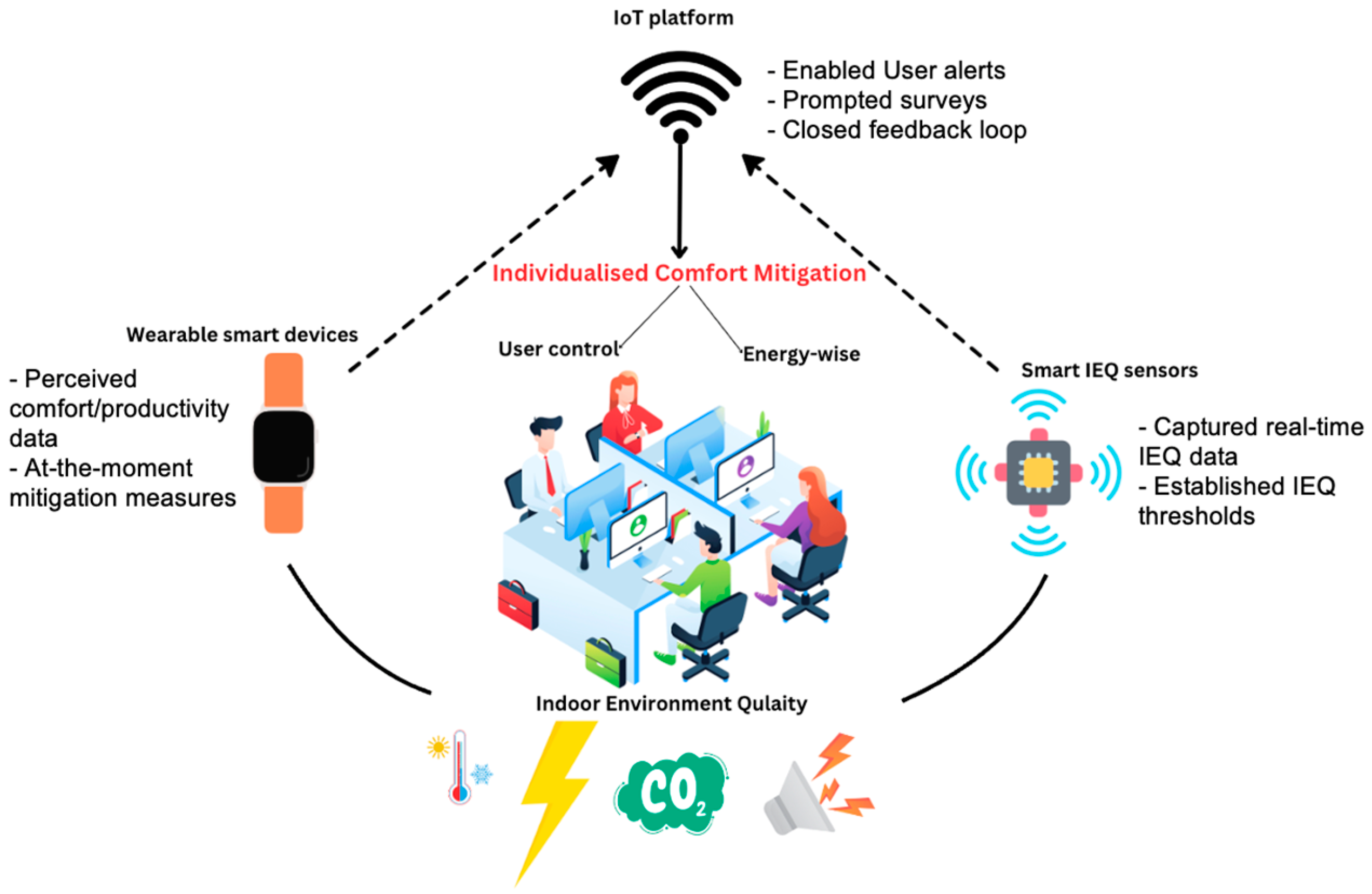
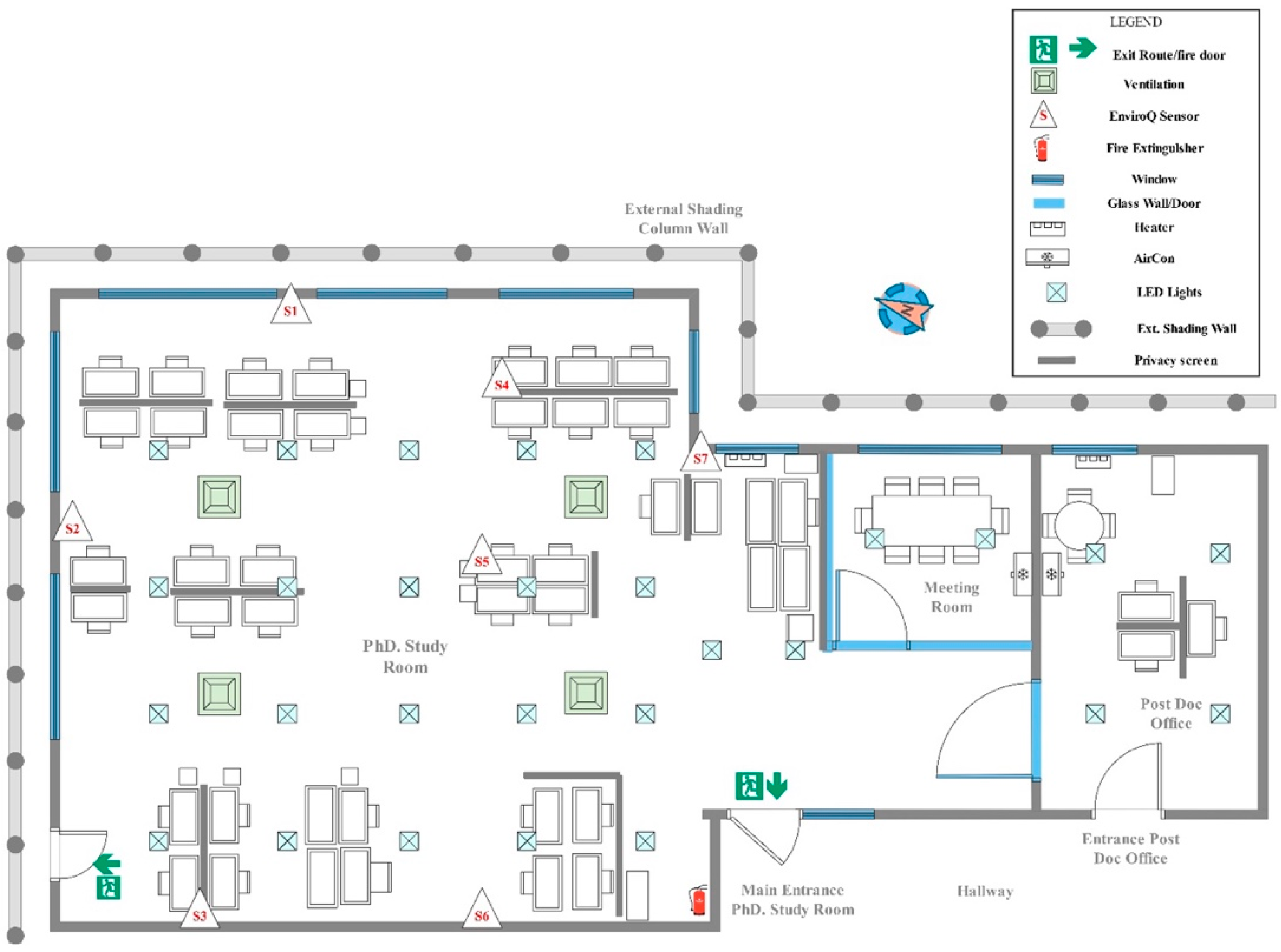
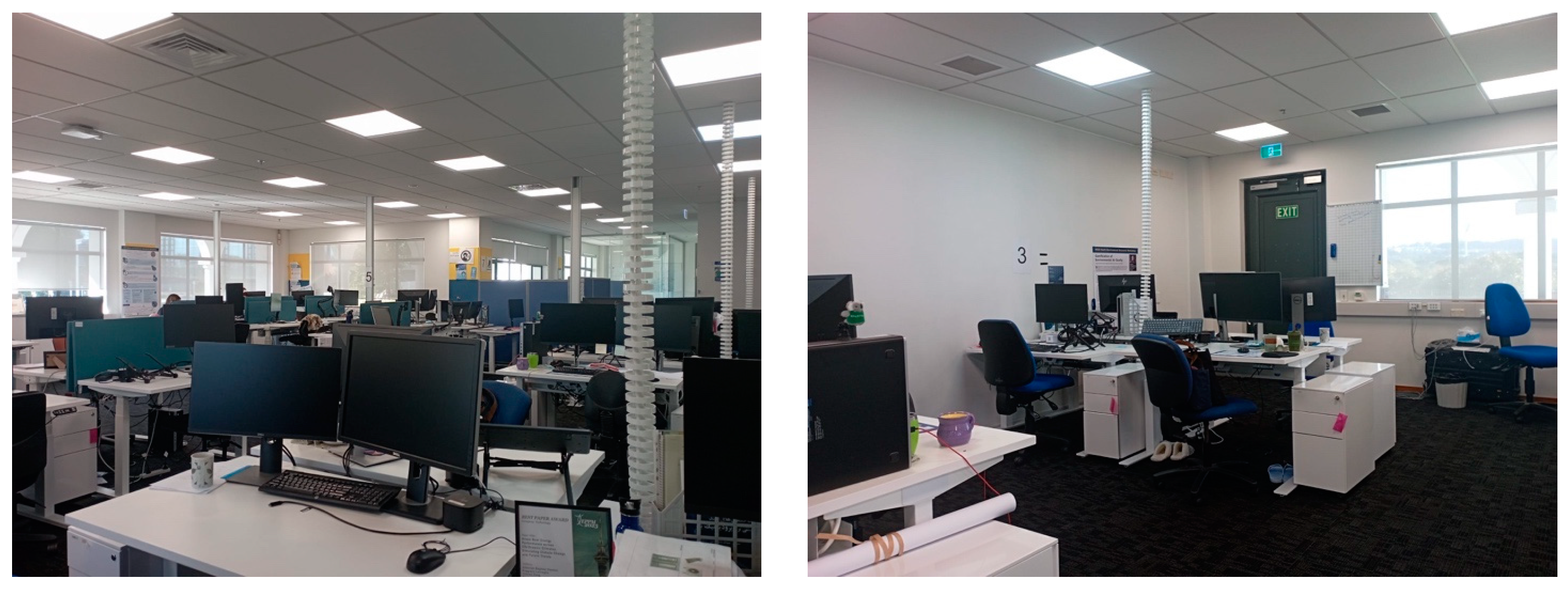
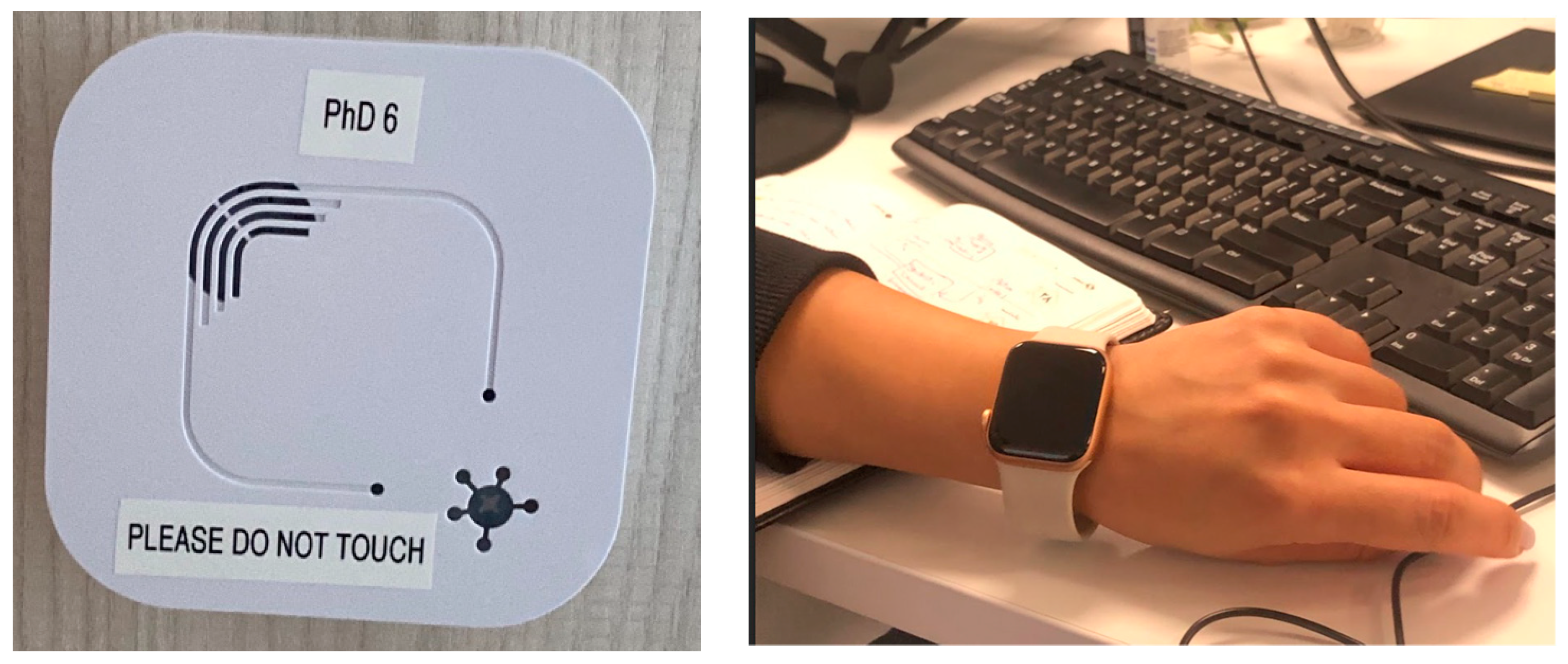
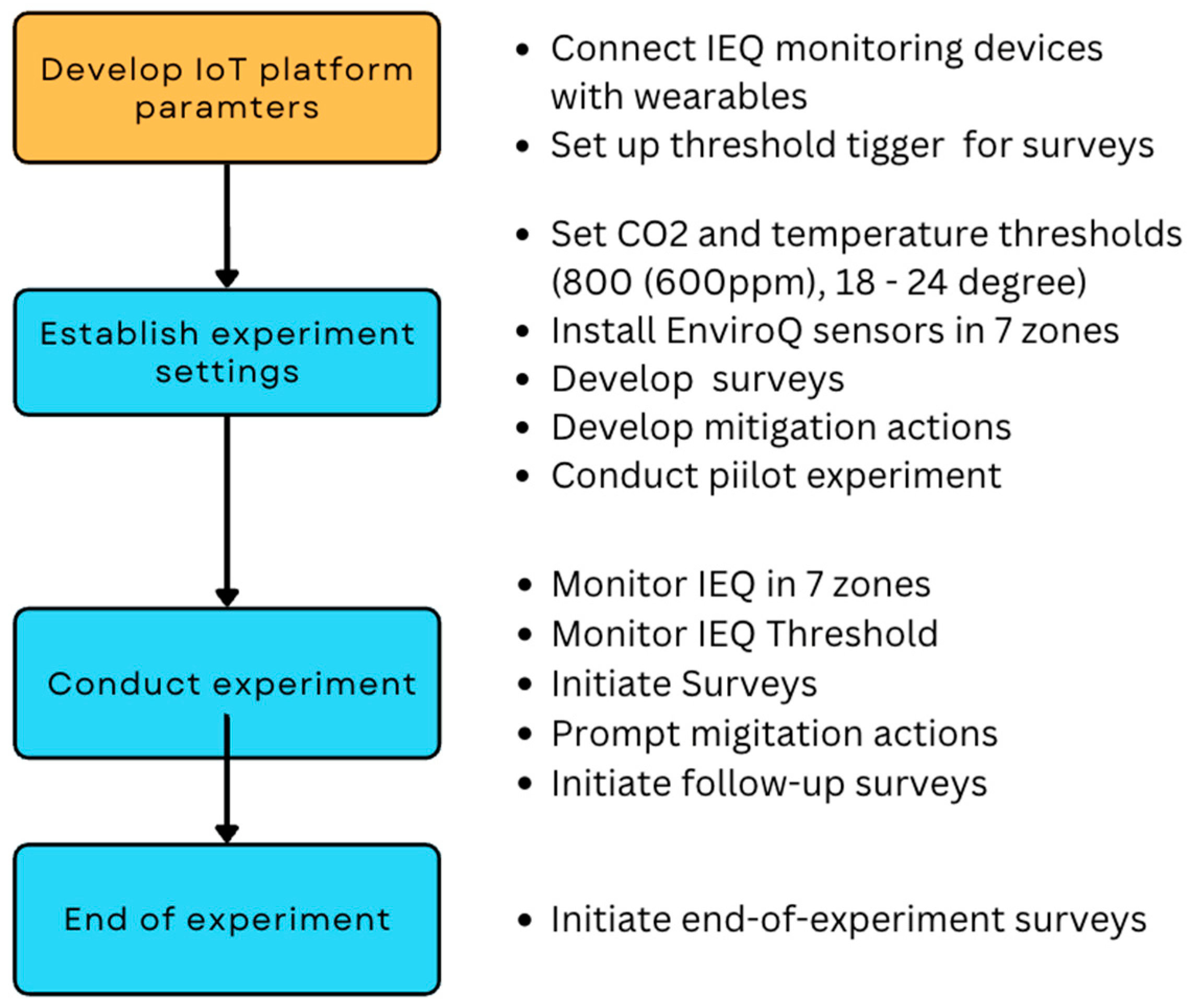

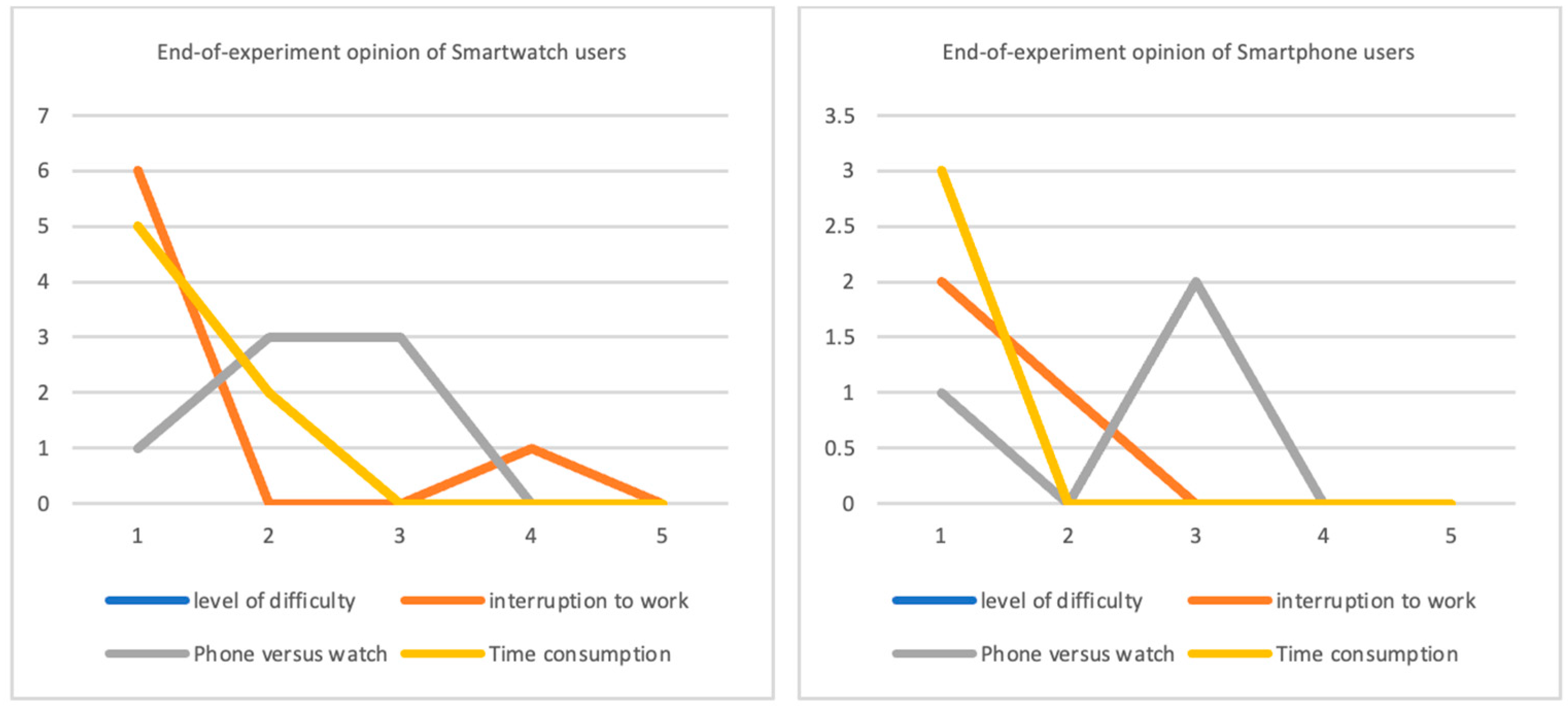
| Zones | User | Gender | Type of Smart Device | |
|---|---|---|---|---|
| Smart Watch | Smart Phone | |||
| Zone 1 | User 1 | Male | √ | |
| Zone 2 | User 2 | Male | √ | |
| Zone 3 | User 3 | Male | √ | |
| Zone 4 | User 4 | Female | √ | |
| User 5 | Female | √ | ||
| User 6 | Female | √ | ||
| Zone 5 | User 7 | Male | √ | |
| Zone 6 | User 8 | Female | √ | |
| User 9 | Male | √ | ||
| Zone 7 | User 10 | Male | √ | |
| Zone | Number of Alarms in Zones | |||||
|---|---|---|---|---|---|---|
| Day 1 | Day 2 | Day 3 | Day 4 | Day 5 | Total | |
| Zone 1 | 4 | 1 | 2 | 4 | 0 | 11 |
| Zone 2 | 2 | 3 | 1 | 1 | 3 | 10 |
| Zone 3 | 3 | 1 | 1 | 1 | 2 | 8 |
| Zone 4 | 4 | 1 | 1 | 2 | 1 | 9 |
| Zone 5 | 1 | 2 | 2 | 0 | 3 | 8 |
| Zone 6 | 5 | 0 | 0 | 1 | 0 | 6 |
| Zone 7 | 2 | 2 | 1 | 3 | 2 | 10 |
| Total | 22 | 10 | 8 | 12 | 11 | 62 |
| Stuffiness of the Air | Productivity Level | Perception of a Healthy Environment | |
|---|---|---|---|
| Number | 52 | 52 | 52 |
| Mean | 2.79 | 3.29 | 3.31 |
| Median | 3.00 | 3.00 | 3.00 |
| Std. Deviation | 0.893 | 0.800 | 0.701 |
| Stuffiness of the Air | Productivity Level | Perception about a Healthy Environment | ||
|---|---|---|---|---|
| CO2 Reading | p-value | 0.004 | 0.006 | 0.058 |
| Correlation Coefficient (r) | 0.395 | −0.379 | −0.264 |
| No = 24 Responses | Stuffiness of the Air | Productivity Level | Perception of a Healthy Environment | |||
|---|---|---|---|---|---|---|
| Before | After | Before | After | Before | After | |
| Mean | 3.00 | 2.58 | 3.21 | 3.42 | 3.29 | 3.63 |
| Median | 3.00 | 3.00 | 3.00 | 3.00 | 3.00 | 4.00 |
| Std. Deviation | 0.885 | 0.717 | 0.658 | 0.584 | 0.690 | 0.647 |
| p-value | 0.018 | 0.132 | 0.059 | |||
| z | −2.357 | −1.508 | −1.886 | |||
| r | 0.48 | - | - | |||
Disclaimer/Publisher’s Note: The statements, opinions and data contained in all publications are solely those of the individual author(s) and contributor(s) and not of MDPI and/or the editor(s). MDPI and/or the editor(s) disclaim responsibility for any injury to people or property resulting from any ideas, methods, instructions or products referred to in the content. |
© 2024 by the authors. Licensee MDPI, Basel, Switzerland. This article is an open access article distributed under the terms and conditions of the Creative Commons Attribution (CC BY) license (https://creativecommons.org/licenses/by/4.0/).
Share and Cite
Rasheed, E.; Wang, K.; Hashemi, A.; Mahmoodi, M.; Panchalingam, K. Integrating Internet of Things (IoT) Approach to Post-Occupancy Evaluation (POE): An Experimental At-the-Moment Occupant Comfort Control System. Buildings 2024, 14, 2095. https://doi.org/10.3390/buildings14072095
Rasheed E, Wang K, Hashemi A, Mahmoodi M, Panchalingam K. Integrating Internet of Things (IoT) Approach to Post-Occupancy Evaluation (POE): An Experimental At-the-Moment Occupant Comfort Control System. Buildings. 2024; 14(7):2095. https://doi.org/10.3390/buildings14072095
Chicago/Turabian StyleRasheed, Eziaku, Kris Wang, Ali Hashemi, Masoud Mahmoodi, and Kajavathani Panchalingam. 2024. "Integrating Internet of Things (IoT) Approach to Post-Occupancy Evaluation (POE): An Experimental At-the-Moment Occupant Comfort Control System" Buildings 14, no. 7: 2095. https://doi.org/10.3390/buildings14072095








